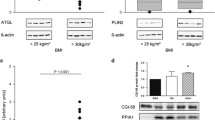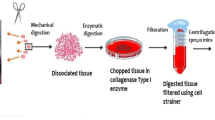Abstract
Background
The fetal fraction of cell-free DNA (cfDNA) in maternal plasma is decreased in obese women. The underlying mechanism is not well understood. The amount of cfDNA released from the placenta has not been directly examined in maternal obesity.
Objective
We sought to quantify release of cfDNA from the placenta and fetal membranes in maternal diet-induced obesity using explant cultures in an established mouse model.
Study Design
C57BL6/J females were fed either 60% high-fat diet or 10% fat-matched control diet for 14 weeks prepregnancy and throughout gestation. Placentas and fetal membranes were collected on e18 and randomly allocated to time 0-, 1-, or 6-hour culture times. The CfDNA was isolated from culture media, quantified, and normalized to tissue weight.
Results
Placentas from obese dams released significantly less cfDNA compared to those of lean dams at time 0 (45.8 ± 4.3 ng/mg vs 65.6 ± 7.9 ng/mg, P =.02). Absolute cfDNA levels increased with longer placental culture, with no significant differences between obese and lean dams at 1 and 6 hours. Membranes released significantly less cfDNA than did placentas at every time point.
Conclusions
Maternal obesity is associated with decreased release of cfDNA from the placenta compared to lean controls immediately after tissue harvest. This may provide an alternative explanation for the lower fetal fraction of cfDNA noted in maternal obesity.
Similar content being viewed by others
References
Lo YM, Corbetta N, Chamberlain PF, et al. Presence of fetal DNA in maternal plasma and serum. Lancet. 1997;350(9076):485–487.
Tjoa ML, Cindrova-Davies T, Spasic-Boskovic O, Bianchi DW, Burton GJ. Trophoblastic oxidative stress and the release of cell-free feto-placental DNA. Am J Pathol. 2006;169(2):400–404.
Alberry MS, Maddocks DG, Hadi MA, et al. Quantification of cell free fetal DNA in maternal plasma in normal pregnancies and in pregnancies with placental dysfunction. Am J Obstet Gynecol. 2009;200(1):98.e91–e96.
Al Nakib M, Desbriere R, Bonello N, et al. Total and fetal cell-free DNA analysis in maternal blood as markers of placental insufficiency in intrauterine growth restriction. Fetal Diagn Ther. 2009;26(1):24–28.
Sifakis S, Koukou Z, Spandidos DA. Cell-free fetal DNA and pregnancy-related complications (review). Mol Med Rep. 2015;11(4):2367–2372.
Dugoff L, Barberio A, Whittaker PG, Schwartz N, Sehdev H, Bastek JA. Cell-free DNA fetal fraction and preterm birth. Am J Obstet Gynecol. 2016;215(2):231 e231–237.
Herrera CA, Stoerker J, Carlquist J, et al. Cell-free DNA, inflammation, and the initiation of spontaneous term labor. Am J Obstet Gynecol. 2017;217(5):583.e581–e588.
Scott FP, Menezes M, Palma-Dias R, et al. Factors affecting cell-free DNA fetal fraction and the consequences for test accuracy. J Matern Fetal Neonatal Med. 2018;31(14):1865–1872.
Poon LC, Musci T, Song K, Syngelaki A, Nicolaides KH. Maternal plasma cell-free fetal and maternal DNA at 11–13 weeks’ gestation: relation to fetal and maternal characteristics and pregnancy outcomes. Fetal Diagn Ther. 2013;33(4):215–223.
Palomaki GE, Kloza EM, Lambert-Messerlian GM, et al. DNA sequencing of maternal plasma to detect Down syndrome: an international clinical validation study. Genet Med. 2011;13(11):913–920.
Ashoor G, Syngelaki A, Poon LC, Rezende JC, Nicolaides KH. Fetal fraction in maternal plasma cell-free DNA at 11–13 weeks’ gestation: relation to maternal and fetal characteristics. Ultrasound Obstet Gynecol. 2013;41(1):26–32.
Zhou Y, Zhu Z, Gao Y, et al. Effects of maternal and fetal characteristics on cell-free fetal DNA fraction in maternal plasma. Reprod Sci. 2015;22(11):1429–1435.
Wataganara T, Peter I, Messerlian GM, Borgatta L, Bianchi DW. Inverse correlation between maternal weight and second trimester circulating cell-free fetal DNA levels. Obstet Gynecol. 2004;104(3):545–550.
Vora NL, Johnson KL, Basu S, Catalano PM, Hauguel-De Mouzon S, Bianchi DW. A multifactorial relationship exists between total circulating cell-free DNA levels and maternal BMI. Prenat Diagn. 2012;32(9):912–914.
Canick JA, Palomaki GE, Kloza EM, Lambert-Messerlian GM, Haddow JE. The impact of maternal plasma DNA fetal fraction on next generation sequencing tests for common fetal aneuploidies. Prenat Diagn. 2013;33(7):667–674.
Edlow AG, Guedj F, Pennings JL, Sverdlov D, Neri C, Bianchi DW. Males are from Mars, and females are from Venus: sex-specific fetal brain gene expression signatures in a mouse model of maternal diet-induced obesity. Am J Obstet Gynecol. 2016;214(5):623 e621–623 e610.
Menon R. Human fetal membranes at term: dead tissue or signalers of parturition?. Placenta. 2016;44:1–5.
Kumagai K, Otsuki Y, Ito Y, Shibata MA, Abe H, Ueki M. Apoptosis in the normal human amnion at term, independent of Bcl-2 regulation and onset of labour. Mol Hum Reprod. 2001;7(7):681–689.
Lei H, Furth EE, Kalluri R, et al. A program of cell death and extracellular matrix degradation is activated in the amnion before the onset of labor. J Clin Invest. 1996;98(9):1971–1978.
Menon R, Boldogh I, Hawkins HK, et al. Histological evidence of oxidative stress and premature senescence in preterm premature rupture of the human fetal membranes recapitulated in vitro. Am J Pathol. 2014;184(6):1740–1751.
Menon R. Oxidative stress damage as a detrimental factor in preterm birth pathology. Front Immunol. 2014;5:567.
Kang SS, Kurti A, Fair DA, Fryer JD. Dietary intervention rescues maternal obesity induced behavior deficits and neuroinflammation in offspring. J Neuroinflammation. 2014;11:156.
Gallou-Kabani C, Gabory A, Tost J, et al. Sex- and diet-specific changes of imprinted gene expression and DNA methylation in mouse placenta under a high-fat diet. PLoS One. 2010;5(12):e14398.
Krasnow SM, Nguyen ML, Marks DL. Increased maternal fat consumption during pregnancy alters body composition in neonatal mice. Am J Physiol Endocrinol Metab. 2011;301(6):E1243–E1253.
Gallou-Kabani C, Vige A, Gross MS, et al. C57BL/6 J and A/J mice fed a high-fat diet delineate components of metabolic syndrome. Obesity (Silver Spring). 2007;15(8):1996–2005.
Phillippe M, Adeli S. Cell-free DNA release by mouse placental explants. Plos One. 2017;12(6):e0178845.
Miller RK, Genbacev O, Turner MA, Aplin JD, Caniggia I, Huppertz B. Human placental explants in culture: approaches and assessments. Placenta. 2005;26(6):439–448.
Phillippe M. Cell-free fetal DNA—a trigger for parturition. N Engl J Med. 2014;370(26):2534–2536.
de Leon PM, Campos VF, Dellagostin OA, Deschamps JC, Seixas FK, Collares T. Equine fetal sex determination using circulating cell-free fetal DNA (ccffDNA). Theriogenology. 2012;77(3):694–698.
Kadivar A, Hassanpour H, Mirshokraei P, Azari M, Gholamhosseini K, Karami A. Detection and quantification of cell-free fetal DNA in ovine maternal plasma; use it to predict fetal sex. Theriogenology. 2013;79(6):995–1000.
Khosrotehrani K, Wataganara T, Bianchi DW, Johnson KL. Fetal cell-free DNA circulates in the plasma of pregnant mice: relevance for animal models of fetomaternal trafficking. Hum Reprod. 2004;19(11):2460–2464.
Wang G, Cui Q, Cheng K, Zhang X, Xing G, Wu S. Prediction of fetal sex by amplification of fetal DNA present in cow plasma. J Reprod Dev. 2010;56(6):639–642.
Taglauer ES, Wilkins-Haug L, Bianchi DW. Review: cell-free fetal DNA in the maternal circulation as an indication of placental health and disease. Placenta. 2014;35(suppl):S64–S68.
Edlow AG, Bianchi DW. Tracking fetal development through molecular analysis of maternal biofluids. Biochim Biophys Acta. 2012;1822(12):1970–1980.
Lo YM, Tein MS, Lau TK, et al. Quantitative analysis of fetal DNA in maternal plasma and serum: implications for noninvasive prenatal diagnosis. Am J Hum Genet. 1998;62(4):768–775.
Fan HC, Blumenfeld YJ, Chitkara U, Hudgins L, Quake SR. Noninvasive diagnosis of fetal aneuploidy by shotgun sequencing DNA from maternal blood. Proc Natl Acad Sci U S A. 2008;105(42):16266–16271.
Norton ME, Wapner RJ. Cell-free DNA analysis for noninvasive examination of trisomy. N Engl J Med. 2015;373(26):2582.
Bianchi DW, Platt LD, Goldberg JD, et al. Genome-wide fetal aneuploidy detection by maternal plasma DNA sequencing. Obstet Gynecol. 2012;119(5):890–901.
Lapaire O, Volgmann T, Grill S, et al. Significant correlation between maternal body mass index at delivery and in the second trimester, and second trimester circulating total cell-free DNA levels. Reprod Sci. 2009;16(3):274–279.
Luzzo KM, Wang Q, Purcell SH, et al. High fat diet induced developmental defects in the mouse: oocyte meiotic aneuploidy and fetal growth retardation/brain defects. Plos One. 2012;7(11):e49217.
Kamimae-Lanning AN, Krasnow SM, Goloviznina NA, et al. Maternal high-fat diet and obesity compromise fetal hematopoiesis. Mol Metab. 2015;4(1):25–38.
Ferrari F, Facchinetti F, Ontiveros AE, et al. The effect of combined inositol supplementation on maternal metabolic profile in pregnancies complicated by metabolic syndrome and obesity. Am J Obstet Gynecol. 2016;215(4):503 e501–508.
Murabayashi N, Sugiyama T, Zhang L, et al. Maternal high-fat diets cause insulin resistance through inflammatory changes in fetal adipose tissue. Eur J Obstet Gynecol Reprod Biol. 2013;169(1):39–44.
Leguizamon G, Trigubo D, Pereira JI, Vera MF, Fernandez JA. Vascular complications in the diabetic pregnancy. Curr Diab Rep. 2015;15(4):22.
Myatt L, Maloyan A. Obesity and placental function. Semin Reprod Med. 2016;34(1):42–49.
Pendeloski KPT, Ono E, Torloni MR, Mattar R, Daher S. Maternal obesity and inflammatory mediators: a controversial association. Am J Reprod Immunol. 2017;77(5).
Higgins L, Mills TA, Greenwood SL, Cowley EJ, Sibley CP, Jones RL. Maternal obesity and its effect on placental cell turnover. J Matern Fetal Neonatal Med. 2013;26(8):783–788.
Edlow AG, Vora NL, Hui L, Wick HC, Cowan JM, Bianchi DW. Maternal obesity affects fetal neurodevelopmental and metabolic gene expression: a pilot study. Plos One. 2014;9(2):e88661.
Kang X, Xia J, Wang Y, et al. An advanced model to precisely estimate the cell-free fetal DNA concentration in maternal plasma. Plos One. 2016;11(9):e0161928.
Livergood MC, LeChien KA, Trudell AS. Obesity and cell-free DNA “no calls”: is there an optimal gestational age at time of sampling? Am J Obstet Gynecol. 2017;216(4):413 e411–413 e419.
Yared E, Dinsmoor MJ, Endres LK, et al. Obesity increases the risk of failure of noninvasive prenatal screening regardless of gestational age. Am J Obstet Gynecol. 2016;215(3):370 e371–376.
Canick JA, Kloza EM, Lambert-Messerlian GM, et al. DNA sequencing of maternal plasma to identify Down syndrome and other trisomies in multiple gestations. Prenat Diagn. 2012;32(8):730–734.
Leung TY, Qu JZ, Liao GJ, et al. Noninvasive twin zygosity assessment and aneuploidy detection by maternal plasma DNA sequencing. Prenat Diagn. 2013;33(7):675–681.
Qu JZ, Leung TY, Jiang P, et al. Noninvasive prenatal determination of twin zygosity by maternal plasma DNA analysis. Clin Chem. 2013;59(2):427–435.
Anelli GM, Cardellicchio M, Novielli C, et al. Mitochondrial content and hepcidin are increased in obese pregnant mothers. J Matern Fetal Neonatal Med. 2018;31(18):2388–2395.
Clifton VL. Review: sex and the human placenta: mediating differential strategies of fetal growth and survival. Placenta. 2010;31(suppl):S33–S39.
Gabory A, Ferry L, Fajardy I, et al. Maternal diets trigger sex-specific divergent trajectories of gene expression and epigenetic systems in mouse placenta. Plos One. 2012;7(11):e47986.
Author information
Authors and Affiliations
Corresponding author
Additional information
Authors’ Note
Study was conducted at Tufts Medical Center, Massachusetts General Hospital.
Rights and permissions
About this article
Cite this article
Mhatre, M., Adeli, S., Norwitz, E. et al. The Effect of Maternal Obesity on Placental Cell-Free DNA Release in a Mouse Model. Reprod. Sci. 26, 1218–1224 (2019). https://doi.org/10.1177/1933719118811647
Published:
Issue Date:
DOI: https://doi.org/10.1177/1933719118811647




